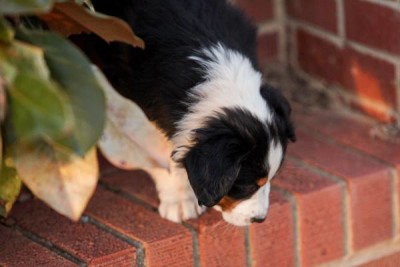I start all my litter puppies at 4 weeks or so around chickens, ducks, and sheep. I want the puppies use to being round the animals and birds so they won’t be afraid. I will take the puppy in the stall with the chickens one at a time and hold the puppy for the first time… and if the pup is okay, I sit the pup on the ground and allow the pup a good look at the chickens. If the puppy wants to move the chickens I am careful to not let the puppy hurt or bite a chicken. At this point, all I do is pick the puppy up and turn it in the opposite direction – if it is too interested. I never say anything to the puppy…not a word.
The puppies are 7 weeks old and have had many exposures to the chickens already.
I allowed the puppies to go to the stall with me to turn the chickens out. The puppies are quite confident by now and are starting to grab chickens by the tail feathers. I do not want the puppies doing this so I discourage using my walking stick. I carry a very light weight, hot pink walking stick. It comes in handy for all sorts of things.
The stall is a smaller area, so the chickens and puppies are close together. To discourage the puppies from grabbing tail feathers, I quietly watch and wait. When the puppy grabs, I take my stick and put it under the chicken’s tail feather and then lift up to discourage the puppy’s behavior. It’s kind of like the chicken is kicking and the puppy doesn’t know it’s me…it thinks the chicken is kicking! Usually after the 3rd or 4th kick from the pink kicking chicken, the pup decides to go to the head of the chicken. If the pup is bad on that end, the chicken will take a peck and pretty soon the puppy learns that both ends of the chicken are not to be messed with. Again I say nothing.
The reason I stay silent is I want the puppy to learn to respect the chicken. Soon the puppy understands that its actions have consequences. The chicken, while not to be feared, is to be respected. When I am not around, and there is a meeting of the puppy and the chicken, the puppy will be less likely to bother the chicken. This takes some time and effort on my part. It is a slow process, but the ground rules are being laid for future work on the farm and anywhere else the puppy may be in life.
This afternoon we took the chickens out into the barn yard, a larger area than the stall. The puppies had learned not to chase or bother the chickens from behind. When the pups at this age go to the chicken’s head, the chicken defends that end very well and the puppies were wise enough to watch and observe, even move the chickens, but no puppy chased. This will be continued until I know for sure the puppy is not going to harm a chicken.
